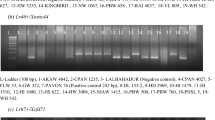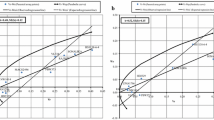Summary
Partial resistance (PR) in wheat to wheat leaf rust (Puccinia recondita f.sp. tritici) is characterized by a slow epidemic build-up despite a susceptible infection type. Two greenhouse tests and two field tests, in which 11 spring wheat cultivars were exposed to five wheat leaf rust races, revealed some indication for race-specificity of PR.
In the greenhouse, the expression of PR was highly dependent on the environment. Significant cultivar-race interactions in the first experiment were lost in the second experiment probably due to cultivar-environment and cultivar-race-environment interactions.
In the polycyclic field tests several factors played a role in explaining the inconsistency of the cultivar-race interactions, such as differences in initial inoculum, genotypic differences in earliness, interplot interference or environmental conditions.
One cultivar-race combination showed a significant but small interaction towards susceptibility in both field experiments. The interaction was probably too small to detect in the monocyclic greenhouse tests. The results do not conflict with the idea that a gene-for-gene relationship could exist between PR-genes in the host and genes in the pathogen.
Some problems with regard to the selection of PR in wheat to wheat leaf rust are discussed.
Similar content being viewed by others
References
Bell, A.A., 1982. Plant pest interaction with environmental stress and breeding for pest resistance: plant diseases In: H.N. Christiansen & C.F. Lewis. (Eds) Breeding for less favorable environments. p335–363.
Broers L.H.M., 1987. Relevance of randomizing host genotypes of wheat that are tested for leaf rust resistance in race nurseries. Euphytica 36: 257–263.
Broers L.H.M., 1989. Partial resistance to wheat leaf rust in 18 spring wheat cultivars. Euphytica 44: 247–258.
Broers L.H.M. & Th.Jacobs, 1989. The inheritance of host plant effect on latency period of wheat leaf rust in spring wheat. II: number of segregating factors and evidence for transgressive segregation in F3 and F5 generations. Euphytica 44: 207–214.
Browder L.E., 1985. Parasite: host: environment specificity in the cereal rusts. Ann Rev Phytopath 23: 201–222.
DeMilliano W.A.J., M.A.Beek & J.C.Zadoks, 1986. International testing of incomplete resistance against brown rust (Puccinia recondita) in IPHR wheat lines. Neth J P1 Path 92: 49–56.
Eyal Z., B.C.Clifford & R.M.Caldwell, 1968. A settling tower for quantitative inoculation of leaf blades of mature small grain plants with urediospores. Phytopathology 60: 461–466.
Kuhn R.C., H.W.Ohm & G.E.Shaner, 1978. Slow leaf rust severity in wheat against twenty two isolates of Puccinia recondita. Phytopathology 68: 651–656.
Kulkarni R.N., V.L.Chopra & D.Sing, 1982. Relative importance of components affecting the leaf rust progress. Theor Appl Gen 62: 205–207.
Lee T.S. & G.E.Shaner, 1985. Oligogene inheritance of length of latency period in six slow leaf-rusting wheat cultivars. Phytopathology 75: 636–643.
McNeal, F.H., C.F. Conzak, E.P. Smith, W.S. Tade & T.S. Russel, 1971. A Uniform system for recording and processing cereal research data. USDA Agric Res Surv Washington DC, ARS 34–121, 42pp.
Parlevliet J.E., 1977. Evidence for differential interaction in the polygene Hordeum vulgare — Puccinia hordei relation during epidemic development. Phytopathology 67: 776–778.
Parlevliet J.E. & A.vanOmmeren, 1975. Partial resistance of barley to leaf rust, Puccinia hordei. II. Relationship between field trials, microplot tests and latent period. Euphytica 24: 293–303.
Parlevliet J.E. & A.vanOmmeren, 1984. Interplot interference and the assessment of barley cultivars for partial resistance to leaf rust, Puccinia hordei. Euphytica 33: 685–697.
Parlevliet J.E. & A.vanOmmeren, 1985. Race-specific effects in major genic and polygenic resistance of barley to leaf rust in the field: identification and distinction. Euphytica 34: 689–695.
Rouse D.I., D.R.MacKenzie & R.R.Nelson, 1981. A relationship between initial inoculum and apparent infection rate in a set of disease progress data for powdery mildew on wheat. Phytopath Z 100: 143–149.
Samborski D.J., 1985. Wheat leaf rust. In: A.P.Roelfs & W.R.Bushnell (Eds). The cereal rusts vol. II Diseases, distribution, epidemiology and control. 259–298. Academic Press, Orlando, Florida.
Shaner G.E. & R.E.Finney, 1980. New sources of slow leaf rusting resistance in wheat. Phytopathology 70: 1183–1186.
Teng P.S., M.J.Blackie & R.C.Close, 1977. A simulation analysis of crop yield loss due to rust disease. Agric Systems 2: 189–198.
Zadoks J.C., T.Chang & C.Konzak, 1974. A decimal code for the growth stages of cereals. Weed Research 14: 415–421.
Author information
Authors and Affiliations
Rights and permissions
About this article
Cite this article
Broers, L.H.M. Race-specific aspects of partial resistance in wheat to wheat leaf rust, Puccinia recondita f.sp. tritici . Euphytica 44, 273–282 (1989). https://doi.org/10.1007/BF00037535
Received:
Accepted:
Issue Date:
DOI: https://doi.org/10.1007/BF00037535




